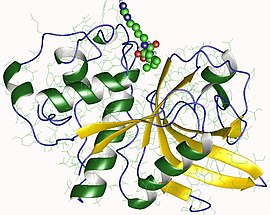Actinidain
| actinidain | |||||||||
|---|---|---|---|---|---|---|---|---|---|
 Ảnh tổ hợp sinh học của actinidain từ Actinidia chinensis. Từ PDB: 1AEC. | |||||||||
| Mã định danh (ID) | |||||||||
| Mã EC | 3.4.22.14 | ||||||||
| Mã CAS | 39279-27-1 | ||||||||
| Các dữ liệu thông tin | |||||||||
| IntEnz | IntEnz view | ||||||||
| BRENDA | BRENDA entry | ||||||||
| ExPASy | NiceZyme view | ||||||||
| KEGG | KEGG entry | ||||||||
| MetaCyc | chu trình chuyển hóa | ||||||||
| PRIAM | profile | ||||||||
| Các cấu trúc PDB | RCSB PDB PDBj PDBe PDBsum | ||||||||
| Bản thể gen | AmiGO / EGO | ||||||||
| |||||||||
Actinidain (EC: 3.4.22.14) còn được gọi là actinidin, actinidia anionic protease là một loại enzyme cysteine protease được tìm thấy trong trái cây bao gồm quả kiwi (chi Dương đào), dứa, xoài, chuối và đu đủ. Enzyme này là một phần của họ peptidase C1 giống như papain.[1][2][3][4]
Là một chất gây dị ứng được biết đến trong quả kiwi,[5] enzyme này đang được nghiên cứu sơ bộ về tác dụng của nó đối với protein dải bịt của tế bào biểu mô ruột.[6][7]
Actinidain có ích về mặt thương mại như một chất làm mềm thịt[8][9] và trong việc làm đông tụ cho các sản phẩm bơ sữa.[10] Nhiệt độ biến tính của actinidain là 60 °C (140 °F), thấp hơn so với các enzyme làm mềm thịt tương tự bromelain từ dứa và papain từ đu đủ.[11]
Tham khảo
[sửa | sửa mã nguồn]- ^ Baker EN, Boland MJ, Calder PC, Hardman MJ (tháng 11 năm 1980). “The specificity of actinidin and its relationship to the structure of the enzyme”. Biochimica et Biophysica Acta. 616 (1): 30–4. doi:10.1016/0005-2744(80)90260-0. PMID 7002215.
- ^ Kamphuis IG, Drenth J, Baker EN (tháng 3 năm 1985). “Thiol proteases. Comparative studies based on the high-resolution structures of papain and actinidin, and on amino acid sequence information for cathepsins B and H, and stem bromelain”. Journal of Molecular Biology. 182 (2): 317–29. doi:10.1016/0022-2836(85)90348-1. PMID 3889350.
- ^ Baker EN, Drenth J (1987). “The thiol proteases: structure and mechanism”. Trong Jurnak FA, McPherson A (biên tập). Active Sites of Enzymes. Biological Macromolecules and Assemblies. 3. New York: John Wiley and Sons. tr. 314–368. ISBN 978-0-471-85142-4.
- ^ Gul S, Mellor GW, Thomas EW, Brocklehurst K (tháng 5 năm 2006). “Temperature-dependences of the kinetics of reactions of papain and actinidin with a series of reactivity probes differing in key molecular recognition features”. The Biochemical Journal. 396 (1): 17–21. doi:10.1042/BJ20051501. PMC 1449998. PMID 16445383.
- ^ Maddumage R, Nieuwenhuizen NJ, Bulley SM, Cooney JM, Green SA, Atkinson RG (tháng 1 năm 2013). “Diversity and relative levels of actinidin, kiwellin, and thaumatin-like allergens in 15 varieties of kiwifruit (Actinidia)”. Journal of Agricultural and Food Chemistry. 61 (3): 728–39. doi:10.1021/jf304289f. PMID 23289429.
- ^ Grozdanovic MM, Čavić M, Nešić A, Andjelković U, Akbari P, Smit JJ, Gavrović-Jankulović M (tháng 3 năm 2016). “Kiwifruit cysteine protease actinidin compromises the intestinal barrier by disrupting tight junctions”. Biochimica et Biophysica Acta. 1860 (3): 516–26. doi:10.1016/j.bbagen.2015.12.005. PMID 26701113.
- ^ Cavic M, Grozdanovic MM, Bajic A, Jankovic R, Andjus PR, Gavrovic-Jankulovic M (tháng 10 năm 2014). “The effect of kiwifruit (Actinidia deliciosa) cysteine protease actinidin on the occludin tight junction network in T84 intestinal epithelial cells”. Food and Chemical Toxicology. 72: 61–8. doi:10.1016/j.fct.2014.07.012. PMID 25042511.
- ^ Bekhit AA, Hopkins DL, Geesink G, Bekhit AA, Franks P (2014). “Exogenous proteases for meat tenderization”. Critical Reviews in Food Science and Nutrition. 54 (8): 1012–31. doi:10.1080/10408398.2011.623247. PMID 24499119.
- ^ Eshamah H, Han I, Naas H, Acton J, Dawson P (tháng 4 năm 2014). “Antibacterial effects of natural tenderizing enzymes on different strains of Escherichia coli O157:H7 and Listeria monocytogenes on beef”. Meat Science. 96 (4): 1494–500. doi:10.1016/j.meatsci.2013.12.010. PMID 24447905.
- ^ Katsaros, George I.; Tavantzis, George; Taoukis, Petros S. (tháng 1 năm 2010). “Production of novel dairy products using actinidin and high pressure as enzyme activity regulator”. Innovative Food Science & Emerging Technologies. 11 (1): 47–51. doi:10.1016/j.ifset.2009.08.007.
- ^ Tarté R (2008). Ingredients in meat products properties, functionality and applications. New York: Springer. ISBN 978-0-387-71327-4.
Liên kết ngoài
[sửa | sửa mã nguồn]- Cơ sở dữ liệu trực tuyến MEROPS đối với protease và các chất ức chế của chúng: C01.007[liên kết hỏng]
- EC 3.4.22.14
- actinidain tại Thư viện Y khoa Quốc gia Hoa Kỳ Medical Subject Headings (MeSH)
Chúng tôi bán
 GIẢM
37%
GIẢM
37%
38.000 ₫
60.000 ₫
 GIẢM
20%
GIẢM
20%
64.000 ₫
80.000 ₫
 GIẢM
31%
GIẢM
31%
58.000 ₫
84.000 ₫
 GIẢM
47%
GIẢM
47%
32.000 ₫
60.000 ₫
 GIẢM
24%
GIẢM
24%
19.000 ₫
25.000 ₫



![[Review phim] Hương mật tựa khói sương](https://tugovo.files.wordpress.com/2018/11/57main169.jpg)
